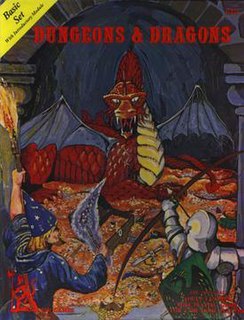This page is based on this
Wikipedia article Text is available under the
CC BY-SA 4.0 license; additional terms may apply.
Images, videos and audio are available under their respective licenses.

Dungeons & Dragons is a fantasy tabletop role-playing game (RPG) originally designed by Gary Gygax and Dave Arneson. It was first published in 1974 by Tactical Studies Rules, Inc. (TSR). The game has been published by Wizards of the Coast since 1997. It was derived from miniature wargames, with a variation of the 1971 game Chainmail serving as the initial rule system. D&D's publication is commonly recognized as the beginning of modern role-playing games and the role-playing game industry.

Dungeon was one of the two official magazines targeting consumers of the Dungeons & Dragons role-playing game and associated products; Dragon was the other.

Dungeons & Dragons: Tower of Doom, published in 1993, is the first of two arcade games created by Capcom based on the Dungeons & Dragons tabletop role-playing game and set in the Mystara campaign setting. It is a side scrolling beat 'em up with some role-playing video game elements mixed in. The game was also released on the Sega Saturn, packaged with its sequel, Dungeons & Dragons: Shadow over Mystara, under the title Dungeons & Dragons Collection, although the Saturn version limited the gameplay to only two players. In 2013, both games were re-released for modern platforms as Dungeons & Dragons: Chronicles of Mystara.

In the Dungeons & Dragons role-playing game, an adventure or module is a pre-packaged book or box set that helps the Dungeon Master manage the plot or story of a game. The term adventure is currently used by the game's publisher Wizards of the Coast.
The Dungeons & Dragons (D&D) fantasy role-playing game has spawned many related products, including magazines, films and video games.

Wherwell is a village on the River Test in Hampshire, England. The name may derive from its bubbling springs resulting in the Middle Ages place name “Hwerwyl” noted in AD 955, possibly meaning “kettle springs” or “cauldron springs.” Pronunciation of the name has ranged from “Hurrell” to “Wer-rel” to present-day “Wher-well.”
Dungeons & Dragons controversies concern the role-playing game Dungeons & Dragons (D&D), which has received significant attention in the media and in popular culture. The game has received negative coverage, especially during the game's early years in the early 1980s. Because the term D&D may be mistakenly used to refer to all types of role-playing games, some controversies regarding D&D actually pertain to role-playing games in general, or to the literary genre of fantasy.
Dungeons & Dragons (D&D) is a fantasy role-playing game first published in 1974. As the popularity of the game grew throughout the late-1970s and 1980s, it became referenced in popular culture more frequently. The complement of games, films and cultural references based on Dungeons & Dragons or similar fantasies, characters, and adventures became ubiquitous after the end of the 1970s.

In the Dungeons & Dragons fantasy roleplaying game, thessalmonsters are a group of related creatures designed to resemble the hydra.

The Dungeons & Dragons Basic Set is a set of rulebooks for the Dungeons & Dragons (D&D) fantasy role-playing game. First published in 1977, it saw a handful of revisions and reprintings. The first edition was written by J. Eric Holmes based on Gary Gygax and Dave Arneson's original work. Later editions were edited by Tom Moldvay, Dave Cook, and Frank Mentzer.

The Dungeons & Dragons Rules Cyclopedia is a 1991 book published by TSR, Inc., as a continuation of the basic edition of the Dungeons & Dragons fantasy role-playing game, which ran concurrently with Advanced Dungeons & Dragons. Its product designation was TSR 1071.
In the Dungeons & Dragons fantasy role-playing game, the pyrolisk is a fictional creature that is very similar in appearance and physical strength to the cockatrice. Their differences lie in the pyrolisk's red tail feathers and special abilities.
Christopher Perkins is a Canadian American game designer and editor who is known for his work on Wizards of the Coast's Dungeons & Dragons role-playing game, currently as the senior story designer.

Dungeons & Dragons: Chronicles of Mystara is a 2013 video game compilation by Capcom released as a digital download for the Wii U, PlayStation 3, Xbox 360 and Microsoft Windows. It includes two arcade games based on the Dungeons & Dragons franchise: Dungeons & Dragons: Tower of Doom (1993) and Dungeons & Dragons: Shadow over Mystara (1996).
Monsters are an important element of the Dungeons & Dragons fantasy role-playing game. Since the game's first edition in 1974, a bestiary was included along other game manuals, first called Monsters & Treasure and now commonly called the Monster Manual. Described as an "essential" part of Dungeons & Dragons, the game's monsters have become notable in their own right, influencing fields such as video games and fiction, as well as popular culture.
Dungeons & Dragons is a fantasy film series based on the role-playing game of the same name by Wizards of the Coast and Hasbro.












